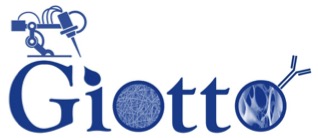
Osteoporosis is a systemic, degenerative disorder, predominantly affecting postmenopausal women (1 out of 3) but also men at an advanced age (1 out of 5) and it increases the prevalence of fracture risk. One fifth of people suffering an osteoporotic fracture will die within a year and half will become dependent. Appropriate anti-osteoporotic drugs are available but have serious side effects and they do not promote fracture healing. The concept behind GIOTTO is to develop a platform of technologies and materials for the treatment of different types of osteoporotic fractures, designing, manufacturing and validating three different solutions:
1) 3D graded scaffold, which can be fixated with screws, to treat long bone fractures
2) Fibrous scaffold to deal with small, not confined pelvic fractures;
3) Radiopaque, bioresorbable, injectable cement to stabilise vertebral fractures.
The three devices will share smart nanobiomaterials that release chemical and biological cues to stimulate bone regeneration while reducing bone loss. Nanofunctionalisation and the smart, temporalised release of active molecules will allow for the systematic cell recruitment and activation needed to face the challenges of stimulating bone tissue regeneration in the elderly. The use of additive manufacturing technologies will enable device personalisation to match and better align with the patient’s anatomy and fracture type. A further boost to meet patient specificity and needs, will be provided through the use of functionalised magnetic nanoparticles in order to provide, via the application of an external oscillating magnetic field, a remote tool to activate mechanotransduction. In parallel, an Internet of Things platform will be developed to gather and collate measurable data inputs about device effectiveness and to provide decision support software as a service to improve the design, manufacture and clinical function of the proposed devices, ultimately managing the overall value chain.
Principal Investigator: Prof. Giovanni Vozzi

